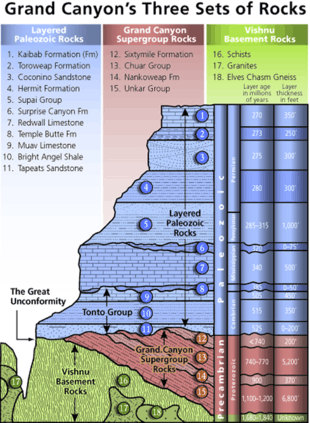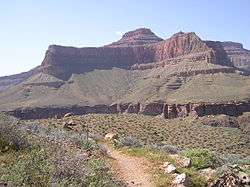Tonto Group
The Cambrian Tonto Group is the three-member sequence of geologic formations that represent the basal section of Paleozoic rocks in the Grand Canyon. The group is about 1,250 feet (381 m) thick.[4] The base unit, the Cambrian Tapeats Sandstone was deposited upon the erosion surface of the Vishnu Basement Rocks, which is found in Granite Gorge (the Inner Gorge). The erosion resistant Tapeats Sandstone forms the platform, called Tonto Platform, that the two less erosion resistant upper layers, the Bright Angel Shale and Muav Limestone, rest upon.
| Tonto Group Stratigraphic range: Cambrian, 508–500 Ma | |
|---|---|
 Muav Limestone-(broader-base gray cliff supporting tall-reddish Redwall Limestone cliff) and Bright Angel Shale-(greenish & extensive slope-former), resting on Tapeats Sandstone-(short, dark vertical cliff on gorge rim) and the Tonto Platform, inner canyon, Granite Gorge (the two units are easily seen below the red-stained Redwall Limestone (~550 ft thick)) | |
| Type | Geologic group |
| Unit of | Sauk sequence |
| Sub-units | 3-Muav Limestone, 2-Bright Angel Shale, 1-Tapeats Sandstone |
| Underlies | Redwall Limestone. (Locally overlain by Temple Butte Formation that fills paleovalleys cut into unconformity separating Redwall Limestone from Muav Limestone.) |
| Overlies | Vishnu Basement Rocks, and 8)-Sixtymile Formation, 7)-Chuar Group, 6)-Nankoweap Formation, 5–1)-Unkar Group, (or Vishnu Basement Rocks and members of the Grand Canyon Supergroup, units 8-1) |
| Thickness | 1,250 feet (380 m) |
| Lithology | |
| Primary | sandstone, conglomerate, siltstone, shale, limestone, and dolomite |
| Other | calcareous mudstone and glauconitic sandstone |
| Location | |
| Region | |
| Country | |
| Type section | |
| Named for | Tonto Creek |
| Named by | Gilbert (1875),[1] (Walcott, 1883),[2] and (Noble, 1914)[3] |

The Tonto Trail is a mostly horizontal trail on the south side of Granite Gorge. The horizontal Tonto Group units are laid upon the Vishnu Basement Rocks above an angular unconformity as the Vishnu Basement Rocks have a dip of about 15 degrees. This erosion unconformity prior to the deposition of the Tapeats upon the tilted Vishnu Basement Rocks is about 1,000 million years (1.0 billion years), and is called the Great Unconformity.
Geologic sequence
The units of the Tonto Group: (~508-500 Mya[5])
 View of Tower of Set peak and sub-unit cliff section from Tonto Trail, Granite Gorge, north of Mohave Point, Grand Canyon Village, South Rim.
View of Tower of Set peak and sub-unit cliff section from Tonto Trail, Granite Gorge, north of Mohave Point, Grand Canyon Village, South Rim.
The peak is behind and separated from a cliff unit (with small prominence), in front-(photo center, right, Tower of Set (peak) to its left).
Vertical erosion in cliff of Redwall Limestone, upon horizontal Muav Limestne cliff.[6] The Tapeats Sandstone sits in foreground on Granite Gorge, and is seen as thinly-bedded. The slope-former above is the Bright Angel Shale with thin, inter-bedding, as well as one resistant cliff unit. The Redwall Limestone cliff section in Grand Canyon is about 450 feet (137 m) thick.[4].jpeg) close-up and far views of the Tonto Group members.
close-up and far views of the Tonto Group members.
Note in far view the cliff-run of the Tapeats Sandstone cliff below the greenish Bright Angel Shale.
See also
| Wikimedia Commons has media related to Tonto Group. |
References
- Gilbert, GK (1875) Report upon the geology of portions of Nevada, Utah, California, and Arizona, Chapter 6. In GM Wheeler, ed., pp. 17-187, Report on the Geographical and Geological Explorations and Surveys West of the One Hundredth Meridian, vol. 3. U.S. Geological and Geographical Survey, Publication of the Wheeler Survey, Washington, D.C., 681 pp.
- Walcott, CD (1883) Pre-Carboniferous strata in the Grand Canyon of the Colorado, Arizona. American Journal of Science, 3d ser., vol. 26, pp. 437-442,484.
- Noble, LF (1914) The Shinumo quadrangle, Grand Canyon district, Arizona. Bulletin no. 549, US Geological Survey, Reston, Virginia.
- Chronic, H (2001) Roadside Geology of Arizona. The Mountaineers Books, Seattle, Washington. (softcover, ISBN 978-0-87842-147-3) p. 179.
- Karlstrom, K.E. (2020). "Redefining the Tonto Group of Grand Canyon and recalibrating the Cambrian time scale". Geology. doi:10.1130/G46755.1.
|access-date=requires|url=(help) - Lucchitta, I. (2001) Hiking Arizona's Geology, Mountaineers's Books, Seattle, Washington. ISBN 0-89886-730-4) pp. 62-68, Kaibab Trail, pp. 66-67, photo and Fig. 10, View to the northwest from the top of the Redwall Limestone along the (S.) Kaibab Trail. The sketch identifies the geologic units visible from here.
Popular publications
- Arizona Road & Recreation Atlas, Benchmark Maps, 2nd Edition, c. 1998, 112 pages, pp. 28–29, 62-63.
- Arizona DeLorme Atlas & Gazetteer, 5th Edition, c. 2002, 76 pages, pp. 24, 32.
- Chronic, Halka (2001) Roadside Geology of Arizona, c. 1983, 23rd printing, Mountain Press Publishing Co. 322 pages. pp. 229–232-(US 89A Marble Canyon – Fredonia), pp. 179–180. (softcover, ISBN 978-0-87842-147-3)
- Lucchitta, I. (2001) Hiking Arizona's Geology, Ivo Lucchitta, c 2001, Mountaineers's Books. (softcover, ISBN 0-89886-730-4)
External links
- Anonymous (2011a) Tonto Group, Stratigraphy of the Parks of the Colorado Plateau. U.S. Geological Survey, Reston, Virginia.
- Anonymous (2011b) Tapeats Sandstone, Stratigraphy of the Parks of the Colorado Plateau. U.S. Geological Survey, Reston, Virginia.
- Anonymous (2011c) Bright Angel Shale, Stratigraphy of the Parks of the Colorado Plateau. U.S. Geological Survey, Reston, Virginia.
- Anonymous (2011c) Muav Limestone, Stratigraphy of the Parks of the Colorado Plateau. U.S. Geological Survey, Reston, Virginia.
- Brandriss, M. (2004) Angular unconformity between Proterozoic and Cambrian rocks, Grand Canyon, Arizona. GeoDIL, A Geoscience Digital Image Library, University of North Dakota, Grand Forks, North Dakota.
- Mathis, A., and C. Bowman (2007) The Grand Age of Rocks: The Numeric Ages for Rocks Exposed within Grand Canyon, Grand Canyon National Park, Arizona, National Park Service, Grand Canyon National Park, Arizona.
- Rowland, S. (nda) Frenchman Mountain Great Unconformity site. Department of Geoscience, University of Nevada, Las Vegas, Nevada.
- Rowland, S. (ndb) Geologic Map of Frenchman Mountain. Department of Geoscience, University of Nevada, Las Vegas, Nevada.
- Rowland, S. (ndc) Frenchman Mountain and the Great Unconformity. Department of Geoscience, University of Nevada, Las Vegas, Nevada.
- Share, J. (2102a) The Great Unconformity of the Grand Canyon and the Late Proterozoic-Cambrian Time Interval: Part I - Defining It.
- Share, J. (2102a) The Great Unconformity and the Late Proterozoic-Cambrian Time Interval: Part II - The Rifting of Rodinia and the "Snowball Earth" Glaciations That Followed.
- Timmons, M. K. Karlstrom, and C. Dehler (1999) Grand Canyon Supergroup Six Unconformities Make One Great Unconformity A Record of Supercontinent Assembly and Disassembly. Boatman's Quarterly Review. vol. 12, no. 1, pp. 29–32.
- Timmons, S. S. (2003) Learning to Read the Pages of a Book (Grand Canyon Geology Training Manual), National Park Service, Grand Canyon National Park, Arizona.